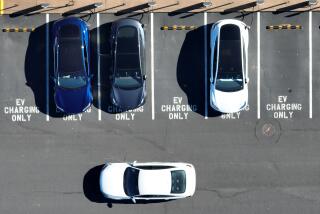Editorial: The right way to charge electric cars
Electric cars are still a relative novelty, even in a state as obsessed with climate change as California. But they’re expected to become a lot more common as carmakers such as Tesla and Chevy start selling electric cars at prices the masses can afford. In fact, if Gov. Jerry Brown gets his way, there will be 1.5 million zero-emission vehicles on California roads by 2025.
The masses aren’t likely to jump on the EV bandwagon, however, unless they can count on a network of electric “filling” stations — places where people can plug in their Model 3s or Bolts for a recharge when they are running out of juice. The state’s largest electric utilities are scrambling to get charging stations built over the next few years at workplaces, apartment buildings, shopping centers and other gathering spots to make these clean-running but slow-charging vehicles more attractive to consumers and to reach the governor’s goal.
In so doing, they are grappling with a fundamental question: Who should pay for and own the fueling centers of the future? The fairest arrangement is for ratepayers and private investors to share the costs and the opportunities, because everyone benefits when an electric vehicle replaces a gas guzzler. That’s the approach employed by the Los Angeles Department of Water and Power and Southern California Edison, which are offering rebates to spur the construction of privately owned charging stations. And it’s the conclusion of the state’s Office of Ratepayer Advocates too.
But two of the state largest electric providers — Pacific Gas & Electric and San Diego Gas & Electric — have sweeping proposals that would require ratepayers to cover 100% of the construction costs, and would give the utilities complete ownership of the new stations’ wires and chargers. This is not good for ratepayers, and it’s even worse for competition — after all, who else could construct charging stations with someone else’s money? Fortunately, there’s still time for utility regulators to amend these proposals and add safeguards to limit ratepayers’ risk. The SDG&E proposal is scheduled for a final vote by the California Public Utilities Commission on Thursday, and PG&E’s is set for approval next month.
Although the PUC has already said it will reduce the number of charging stations in the original proposals by SCG&E and PG&E, the plans are still troubling in their scale and their financing. That’s not a promising way to start addressing the needs of this nascent market. It would be better if regulators used as a model the $22 million pilot program they approved for Edison this month to subsidize 1,500 privately owned charging stations over the next two years. Edison will offer rebates of 25% to 100% of a station’s cost, with the full rebate available only for stations built in low-income communities. A single charger costs about $4,000 today, though that price will surely go down as demand surges. That’s a fairly modest incentive, and the PUC plans to review the program’s effectiveness before letting Edison expand it.
The L.A. DWP is about to launch a second phase of its charging station rebate program. Under the proposal, which is set for a vote by the Board of Water and Power Commissioners on Tuesday, the DWP would spend $2.1 million to provide 100% rebates for new installations. That’s generous and, from the PUC’s point of view, higher than necessary to spark the private market. DWP commissioners should consider adopting sliding-scale rebates based on Edison’s model.
Rebates do require an investment by ratepayers, whether or not they buy electric cars. But Edison says that the cost for the pilot program is so small relative to the utility’s other expenses that it will be virtually unnoticeable to ratepayers. And even the second phase planned by the utility, which would build 30,000 charging stations for $355 million, would add less than $1 to the typical monthly bill. Edison officials say that it’s possible too that a boom in electricity sales could lower everyone’s costs. That would be a plus, but even at current rates it’s a reasonable price to pay for a brighter future.
California should do more to encourage its drivers to trade in their gas-burning cars for the cleaner electric versions, because reducing climate-changing emissions is in everyone’s best interests. As such, it makes sense for everyone to share in the cost of building the charging stations that electric vehicles will need. But to reduce costs and increase innovation, the PUC shouldn’t give utilities a monopoly over the next generation of refueling stops.
Follow the Opinion section on Twitter @latimesopinion and Facebook
More to Read
A cure for the common opinion
Get thought-provoking perspectives with our weekly newsletter.
You may occasionally receive promotional content from the Los Angeles Times.










